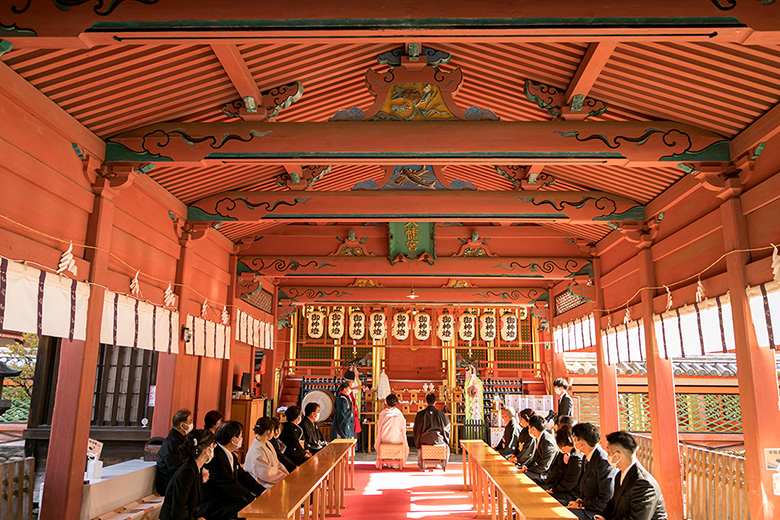Package Price
Price valid all seasons
* Hatsuhoryo is a ceremonial offering to the shrine.
Shinto weddings in Japan originated from Emperor Taisho’s wedding during the Meiji era and later spread to the public.Traditionally, the bride wears a white shiro-muku, and the ceremony is solemnly held before the Shinto gods with close family. While Shinto weddings may seem formal, their structured rituals create a deeper sense of ceremony, making them an increasingly popular choice.
What’s Included
- Shrine Ceremony Fee(non-religious wedding)
- Private room
- Shrine priest
- Music(during the ceremony)
- Kimono for bride and groom
- Makeup & Hairstyling for Bride
- Hair and Makeup Attendant
*Weekend and Public Holiday Surcharge: JPY 33,000
*The amount of the hatsuhoryo varies depending on the shrine.
*Some shrines may require an extra fee.
- Important Information Regarding Shinto Wedding Ceremonies
- Some shrines have a long history and place great importance on tradition and formality. In some cases, the attendance of family members may be required, and casually dressed guests may not be permitted. Please contact us for more details.
Additional Options
- Ceremony Photography
(Approx. 200 photo data)JPY 77,000~ - Upgrade of kimono for BrideJPY 33,000 ~ JPY 165,000
- Upgrade of kimono for GroomJPY 22,000~
- Photographer SelectionJPY 55,000~
- Makeup Artist SelectionJPY 38,500~
- Wedding Videography
(highlight video / ceremony only)JPY 115,500~ - Groom HairstylingJPY 4,400
- Groom Hairstyling & makeupJPY 6,600
- Guest Makeup *1 & 2JPY 5,500
- Guest Hairstyling *2JPY 7,700
- Photo Album *3JPY 33,000~
- English or Chinese interpreterJPY 55,000~
*Tax included in the above prices.
*1)For guests with cosmetic allergies or sensitive skin, please bring your own makeup products.
*2)Availability upon request.
*3)An order of ceremony photography is necessary.
Special Package Complete with Everything You Need

* Hatsuhoryo is a ceremonial offering to the shrine.
What’s Included
- Shrine Ceremony Fee
- Private room(1 hour)
- Shrine priest
- Gagaku Live or BGM(Additional fees may apply)
- Kimono for bride and groom
- Bride: 1 Makeup & Hairstyling
Groom: 1 Hairstyling - Bride Kimono Hair Accessories
- Wedding planner
- Interpreter(English or Mandarin)
- Hair and Makeup Attendant
- Photographer
- Ceremony Photography(Some shrines do not allow photography)
- Shrine Memorial Photos(30 minutes / approx. 50 Photos)
- About 150 Edited Photos(JPG digital files))
* Weekend and Public Holiday Surcharge: JPY 33,000
* Includes undergarments required for the rental attire (juban / kimono undergarments).
* Additional transportation fees may apply depending on the preparation venue.
* Shrine offering fees are not included in the plan price.
* Each shrine has its own rules for ceremonies. Please check and follow them in advance.
* Items included in the plan cannot be refunded if not used.
* All prices shown include tax.
* Shrine fees and regulations may change without notice. Final confirmation will apply.
* Some shrines require couples to use their designated photographers or interpreters.
In such cases, we will offer a discount by applying part of the photography and interpreter fees included in this package.
Wakon Photo Gallery
Wedding Day Schedule
- 1
- Ceremony Preparation
- The couple gathers at our salon for makeup and dressing, then moves to the shrine.
- 2
- Photography at the Shrine
- Shrine Commemorative Photography: Approx. 30 Minutes, Around 50 Final Photos. (Photography of the ceremony bookings only)
- 3
- Pre-Ceremony Briefing
& Rehearsal - Approx. 30-minute briefing and rehearsal. Guests are advised to gather at the shrine 30 minutes before the rehearsal.
- Pre-Ceremony Briefing
- 4
- Ceremony Begins
- Following the traditional Shinto wedding ceremony process, the ritual lasts approximately 30 minutes, followed by group photography. (Photography of the ceremony bookings only)
- 5
- End of Ceremony
- After the group photoshoot, the couple returns to the salon by car for makeup removal and a change into casual attire, concluding the day’s schedule.


























